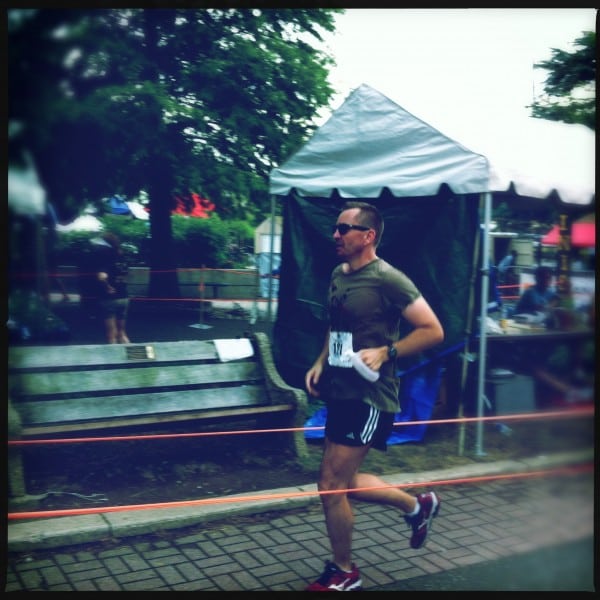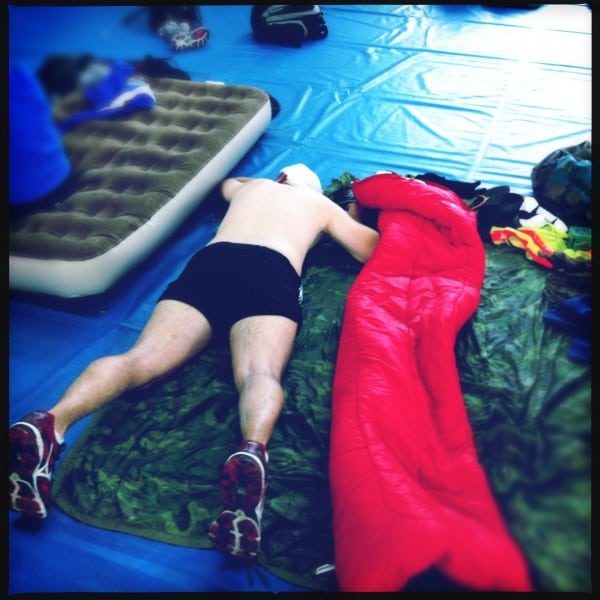[Editor’s note: On July 14th and 15th, new iRunFar contributor, long-time endurance runner, and almost-virgin ultramarathoner Duncan Larkin ran the Stroehmann Back on My Feet 20in24, a 24-hour race in Philadelphia. Here is his story.]
Last year, on our way back home from a dinner date, my wife and I drove past the Philadelphia Art Museum. It was late, and yet we saw tired-looking, bib-wearing runners making their way down West River Drive.
Runners always catch my eye and the fact that they were wearing bibs made them even more appealing to me. I slowed down and shot quick glances at the race unfolding to my right.
‘What were these poor souls up to at midnight?’ I wondered.
When I returned home, I fired up Google and quickly realized that these brave folks I had seen were taking part in the Stroehmann Back on My Feet 20in24 race. Every year, hundreds of runners—some solo “Lone Rangers,” some taking part as a member of a relay team—run seemingly endless 8.4-mile loops on either side of the Schuylkill River.
I already knew about the wonderful things that Anne Mahlum had achieved with her charity, Back on My Feet. Mahlum founded Back on My Feet five years ago. It promotes the self-sufficiency of people experiencing homelessness by engaging them in running,
But I didn’t know there was this race, though.
“I’m doing it next year,” I told my wife. “I’m all over this thing.”
“Doing what?” she asked.
“The 24-hour race,” I said, pointing to the race’s web site. “It’s what we saw those people doing when we were coming back from our dinner date. They were running all day and night.”
My wife demurred. “How are you going to train for this thing?” she asked. “We have a one-year-old baby.”
“I’ll push him in the jog stroller,” I said, pleading with my hands clasped skyward. “I’ll push him everywhere.” When I said this, I imagined five-hour runs in the darkness with my son, Dashiell (Dash), bundled up like an Eskimo baby. I conjured up scenes of Spartan toughness while my spouse got a well-deserved break from child rearing.
She looked at me with screwed-up eyes; she knew this was bullshit.
I gave it one more shot. “I’m turning 40 in April. Let’s call this my ultimate mid-life crisis moment: no mistresses or convertibles. Just this thing: a crazed 24-hour race along the Schuylkill, and then that’s it.”
My wife took a second to think and then finally nodded. Shortly after that, I was officially entered in the 20in24 race.
Training for this thing didn’t go as planned. It never seems to. There was no five-hour jog strolling extravaganza. There was no Eskimo baby runs in the deep snow. There wasn’t even really a long run.
Life got in the way; it always does. I was nearly laid off from my menial job as a defense contractor (a blessing in the end, trust me), and when I wasn’t scrambling about with resume in hand, I was changing diapers and preparing for my next interview.
But I did cobble together some semblance of a running plan. I told myself that whenever I had an extra hour, I’d don my trainers and take to the roads and trails. Most of the time, I had Dash with me. I doubled nearly every day getting anywhere from one to three total hours of running in for a few months and that was about it.
So when the day of the race, July 14, arrived, I was scared. I knew it was going to be a death march.
It was.
The race started at 10 a.m. An hour beforehand, my wife dropped me off in front of the start line at Lloyd Hall. Slung over my back was an ancient rucksack that dated back to the Reagan Administration. It was packed with a completely insufficient amount of supplies: no food, a tiny 9-ounce water bottle, a tub of Bag Balm, a paper-thin poncho liner from my Army days, a container filled with long-since-expired ibuprofen, medical tape for my nipples, a holey towel, and three extra changes of well-worn running clothes.
I pride myself on my ability to live up to the minimalist ideal, but this was flat-out ridiculous.
When I entered Lloyd Hall, I quickly realized that I looked like a fool. Most other runners had created giant, sprawling pleasure palaces in the gymnasium. Some woman listening to music on a pair of giant headphones was lying on a king-sized inflatable mattress. On the other side of a gym, three guys had set up lawn chairs and looked like they were ready to watch a football game and grill brats. Outside, a triple-axle RV rolled into the parking lot.
I found a small space to spread out my little poncho liner and sat down on the hard gym floor to rest my legs before the start.
The race kicked off promptly at 10 a.m. As I headed down the road accompanied by my fellow masochists, I wondered how the hell I was going to pace myself through this thing. My original plan was to walk the first few hours, but that quickly went out the window and by the first mile, I was up with people like perennial winner and course-record holder, Serge Arbona—people I had absolutely no business being near.
But even if I’m not prepared, I’m competitive and so there I was for the first 8.4-mile lap. I crossed the line in 1:11, which is 8:27-per-mile pace, which is suicidal.
Second lap: 1:12.
By that point in time, we were all slogging through periods of intense rainfall. In her pre-race briefing, Anne Mahlum told us this was the first time in the race’s six-year history that rain had showed up on race day.
It felt good.
My third lap was much slower, 1:15, and I had begun to establish not only a rhythm, but had also begun to associate patterns that I would repeat to myself on each lap. As the day turned to night, as my legs and feet began to shred, these patterns warped from funny anecdotes and haunting visual cues of sheer terror.
Here are some examples:
Mile 1: “Shirtless dancing water stop man wearing a Bluetooth device in his ear.” This chiseled guy would hand you a water bottle between moves. He danced for 24 hours and was amazing.
Mile 3: “Peanut butter, jelly, and salt.” A little blue refreshment tent that had lots of food had been erected at this point. I usually ended up stuffing pre-made PB&J sandwiches into my mouth and chasing them with salt that I just ate—paper packaging and all. Germs and overdosing from fiber didn’t really matter much to me then.
Mile 5: “Futile fishermen.” By this point, the runners had crossed over to the Schuylkill’s East bank. For some reason, fishermen flock here. In 17 hours of running, I never saw one catch a fish.
Mile 6.5: “General Grant statue.” I’m a student of history and so I would eagerly await the appearance of this brilliant strategic commander from the Civil War. He sits on a bronze horse overlooking Kelly Drive. He’s hunkered down in his raincoat and looks at you with an expressionless face. For a while, when I wasn’t feeling good, I told myself that at least I wasn’t trying to preserve the Union. It could be worse.
The end: “Stupid sculptures.” During the first few laps, I would admire the Ellen Phillips Samuel Memorial Sculpture Garden that was half-a-mile near the end of the loop, but as my joy turned to pain and misery, the early 20th Century sculptures quickly became miserable eyesores.
By the fifth lap, I told myself I was done. My wife had showed up at that point—all smiles and camera snaps, but I greeted her with a frown.
“My back is killing me,” was all I could say. “I’m done.”
She brought me into Lloyd Hall and massaged my back. She had me pop ibuprofen and when she saw that I was laying on a paper-towel like blanket, she told me to get up and run one more lap after a rest. She said she was going to take care of me.
She did.
My wife was there for me after I returned. She brought me a comfortable sleeping bag, bags of protein bars, running tights, fresh running socks, bottles of orange soda, and two packs of gum. When I lay there sprawled out after a lap, she comforted me and told me I was her hero. She chased the moths out of my Reagan rucksack (not kidding), and rubbed my blistered feet.
I wouldn’t have been able to continue without her.
In the end, I completed 10 laps: 84 miles. I did this by 3 a.m., and had seven hours to run a measly 16 miles to make my pre-race goal of 100 miles. But by that tenth lap, as I silently cursed the amazing dancing water stop man and shook my head at Ellen Phillips Samuel’s dopey sculptures, I limped into Lloyd Hall and rolled up into a fetal ball. I was done and there was nothing anybody could do about it. No pep talks could get me to take one more measly step.
For me, the race was over.
That next morning, my wife picked me up near the finish line. “Well at least you got that out of your system,” she said, staring down the road.
I looked at the brave souls in front of the Art Museum—all the limpers and crab walkers still out there. I took a deep breath.
“Maybe,” I said. “Well see.”


